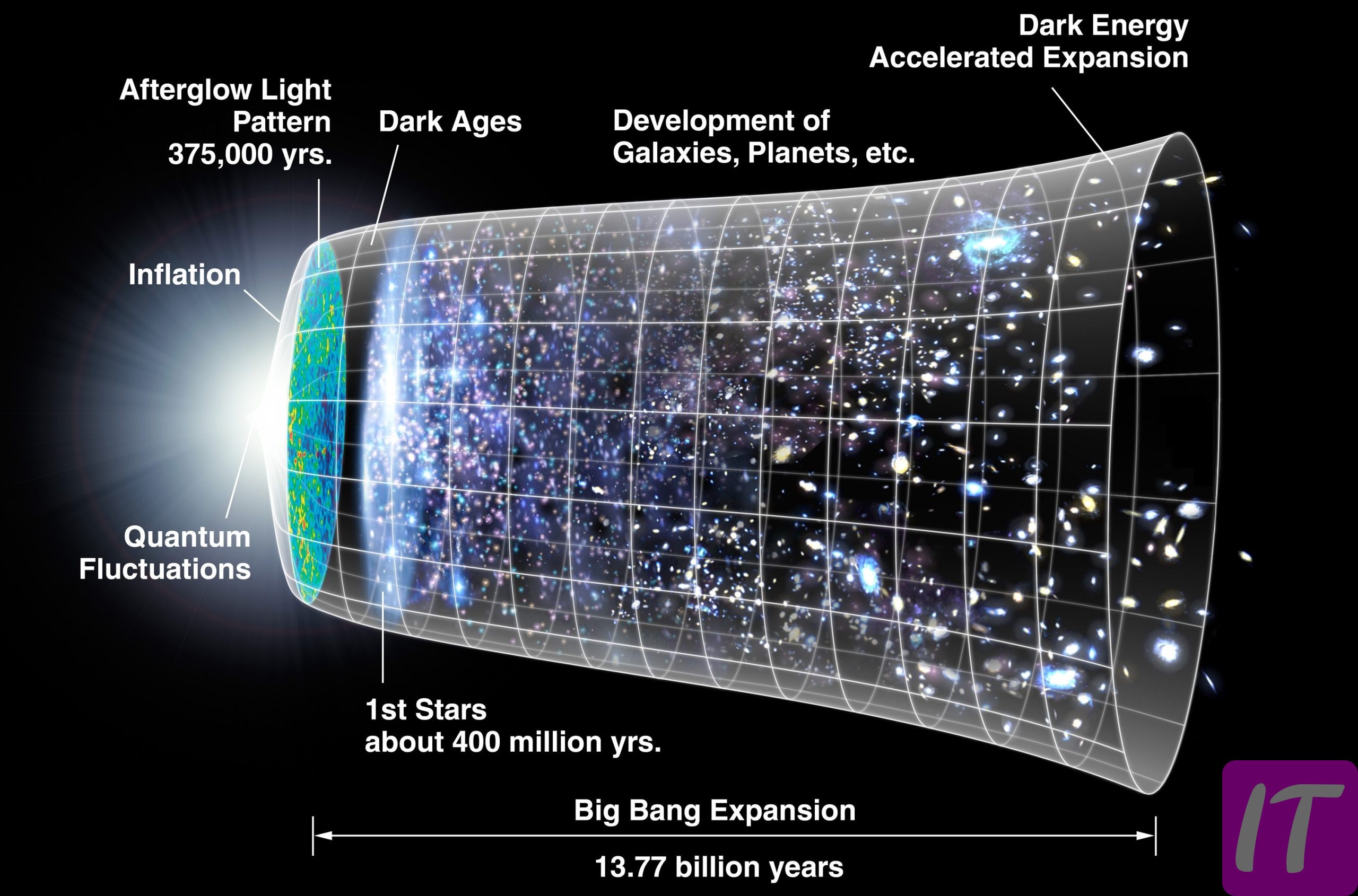With an estimated 13.8 billion years having passed since the universe’s inception, the Big Bang theory elicits a rich tapestry of cosmological intrigue. How did this initial singularity transition into the boundless cosmos we observe today? This enigma sparks curiosity and fuels countless scientific endeavors.
Tracing back to a singular point of infinite density and temperature, the Big Bang marked the birth of our universe. This event, rooted in theoretical physics and astrophysical evidence, gave rise to the expanding space-time continuum. NASA’s Cosmic Background Explorer confirmed this expansion, solidifying the theory with incontrovertible cosmic microwave background radiation data.

Explaining the Big Bang Theory
The Big Bang Theory explains the origin of the universe. According to this theory, the universe began as a very hot, dense point about 13.8 billion years ago. This point, known as a singularity, started expanding rapidly. This expansion caused the universe to cool down and spread out. Over billions of years, this led to the formation of galaxies, stars, and planets.
Scientists have found several pieces of evidence to support the Big Bang Theory. One of the key pieces is the cosmic microwave background radiation. This radiation is the leftover heat from the Big Bang itself. It’s spread out evenly across the universe, providing clues about its early conditions. Other evidence includes the observed expansion of the universe, noted by astronomers like Edwin Hubble.
The expansion of the universe is a crucial aspect of the Big Bang Theory. As the universe expands, galaxies move away from each other. This movement can be compared to dots on a balloon that’s being blown up. The further away a galaxy is, the faster it moves. This relationship is described by Hubble’s Law, which states that the speed of a galaxy’s recession is proportional to its distance from us.
The Big Bang Theory also links to elements found in space. Shortly after the big bang, simple elements like hydrogen and helium formed. These elements later combined to create stars and more complex elements. A clear pattern can be seen in the universe’s composition, matching predictions made by the Big Bang Theory. This consistency further strengthens the theory’s validity.
The Initial Singularity and the Birth of the Universe
The Big Bang began from a point called the initial singularity. This was a tiny, hot, and incredibly dense point that contained all the mass and energy of the universe. Imagine everything in the universe compressed into a space smaller than a pinhead. Scientists believe that this singularity suddenly expanded in an event called the Big Bang. This expansion set the stage for the creation of everything we know.
The initial singularity was not a typical explosion. It was an expansion of space itself, not an explosion into existing space. As space expanded, it cooled and matter began to form. The early universe was a hot soup of particles, including protons, neutrons, and electrons. These particles eventually came together to create the first atoms.
Within the first few minutes after the Big Bang, the universe was hot enough for nuclear fusion to occur. This process created the nuclei of the simplest elements, like hydrogen and helium. Over time, as the universe continued to expand and cool, these nuclei captured electrons, forming stable atoms. These atoms are the building blocks of stars and galaxies.
The birth of the universe from the initial singularity set the foundation for all cosmic structures. Over billions of years, gravity pulled atoms together into clouds of gas, leading to the formation of stars and galaxies. These stars produced heavier elements through nuclear fusion. Studying these early conditions helps us understand the universe’s origins and its future.
The Role of Cosmological Evidence in the Big Bang Theory
Several key pieces of cosmological evidence support the Big Bang Theory. One of the most significant is the observation that the universe is expanding. This was first noted by astronomer Edwin Hubble, who discovered that distant galaxies are moving away from us. The farther away a galaxy is, the faster it seems to be moving. This finding supports the idea that the universe began from a single point.
The cosmic microwave background radiation (CMB) is another crucial piece of evidence. This faint glow fills the universe and is a remnant of the early stages of the universe. Discovered by Arno Penzias and Robert Wilson in 1965, CMB provides a snapshot of the universe when it was just 380,000 years old. Its uniformity and slight variations offer clues about the universe’s infancy.
Elements in space offer additional evidence for the Big Bang Theory. According to the theory, the early universe was hot enough for nuclear fusion to occur, creating the first elements like hydrogen and helium. The proportions of these elements match what scientists observe today. This consistency in elemental abundances strengthens the case for the Big Bang.
Observations of cosmic structures also play a role in supporting the Big Bang Theory. Large-scale structures like galaxies and galaxy clusters form patterns that can be traced back to initial density fluctuations in the early universe. These patterns, seen in CMB maps, provide a direct link to the conditions shortly after the Big Bang. Such evidence helps scientists understand the formation and evolution of the universe.
The Expanding Universe and Cosmic Microwave Background Radiation
The discovery that the universe is expanding was a groundbreaking revelation. Edwin Hubble observed that galaxies are moving away from us, indicating that the universe itself is growing. This expansion suggests that the universe began from a single point. It’s like a balloon being blown up, where all the points on the balloon move away from each other as it inflates. Hubble’s Law, which states that the velocity of a galaxy’s movement is directly proportional to its distance, supports this idea.
Hubble’s observation was a key milestone in supporting the Big Bang Theory. His findings challenged the previous belief that the universe was static and unchanging. This expanding nature implies that the universe had a beginning. It raised questions about what caused the universe to start expanding in the first place. Answering these questions has been a driving force in cosmology.
The cosmic microwave background radiation (CMB) provides even more evidence for the Big Bang Theory. Discovered in 1965 by Arno Penzias and Robert Wilson, CMB is the afterglow of the Big Bang. It fills the universe almost uniformly, like the heat left in an oven after you turn it off. This radiation gives us a snapshot of the universe when it was just 380,000 years old. Studying CMB helps scientists understand the universe’s early conditions.
The uniformity of the CMB puzzled scientists at first. Why was it so evenly spread out? Tiny temperature fluctuations in the CMB reveal information about the early universe’s structure. These fluctuations served as seeds for the formation of galaxies and other cosmic structures. By examining these small variations, scientists can learn about the universe’s evolution.
Analyzing CMB has led to significant breakthroughs in cosmology. It allowed scientists to determine the universe’s age, which is about 13.8 billion years. It also provided insights into the universe’s composition, including dark matter and dark energy. This research continues to shape our understanding of the cosmos.
Linking Theoretical Physics and the Big Bang Theory
Theoretical physics plays a crucial role in understanding the Big Bang Theory. Concepts from physics help explain how the universe began and expanded. For example, general relativity, Einstein’s theory, describes how gravity works on a large scale. It shows how space and time are interconnected, supporting the idea of an expanding universe. Additionally, quantum mechanics helps explain the behavior of particles in the earliest moments after the Big Bang.
General relativity made many predictions that align with the Big Bang Theory. One such prediction is the existence of black holes, which are regions of space where gravity is so strong that nothing can escape. This theory also predicts the expansion of the universe. The equations from general relativity suggest that the universe had a definite beginning. These predictions have been supported by numerous observations.
Quantum mechanics examines the behavior of particles at very small scales. According to this theory, particles can exist in multiple states at once and behave unpredictably. During the Big Bang, the universe was incredibly hot and dense, making it a prime environment for quantum effects. Studying these effects helps scientists understand how matter and energy behaved in the universe’s infancy. This knowledge is essential for piecing together the events that followed.
Inflation theory is another significant aspect of theoretical physics in the Big Bang Theory. It proposes that the universe underwent a rapid expansion in the first fractions of a second after the Big Bang. This inflationary period helps explain why the universe appears uniform on a large scale. It also accounts for the tiny fluctuations seen in the cosmic microwave background. Understanding inflation is key to understanding the early universe.
String theory also contributes to our understanding of the Big Bang. This theory suggests that the most fundamental particles aren’t point-like but rather tiny, vibrating strings. These strings could help describe the forces of nature and the particles that make up the universe. Researchers hope that string theory will one day provide a unified framework for understanding all physical phenomena, including the conditions at the moment of the Big Bang.
The Future Implications of Understanding the Big Bang
Understanding the Big Bang has significant implications for our future. One major area is in the field of cosmology, where scientists continue to explore how the universe began and developed. By studying the Big Bang, researchers can make predictions about the universe’s future. This could help us understand whether the universe will keep expanding, slow down, or even collapse. These insights can shape our understanding of cosmic events yet to unfold.
The Big Bang Theory also impacts other scientific fields, such as particle physics and astronomy. It helps scientists build more accurate models of the universe’s origin and evolution. These models are crucial for predicting how galaxies, stars, and planets form and behave. A deeper understanding of the Big Bang can lead to discoveries about the fundamental nature of matter and energy. This information is valuable for pushing the boundaries of human knowledge.
This understanding influences our technology and daily life. Research related to the Big Bang has led to the development of advanced technologies, including satellite communication and medical imaging. The same principles used to study the cosmos also apply to developing new devices and improving existing ones. These technological advancements have wide-reaching benefits.
There are also philosophical and existential implications. Understanding the Big Bang can change how we view our place in the universe. It prompts questions about the nature of existence and the possibility of multiverses. Exploring these ideas can lead to a profound sense of awe and curiosity.
Moreover, the study of the Big Bang encourages international collaboration. Scientists from around the world work together on projects like the Large Hadron Collider to unravel the mysteries of the universe’s origin. This collaboration fosters unity and shared goals among different nations. It underscores the importance of global cooperation in advancing scientific knowledge.

Frequently Asked Questions
The Big Bang Theory provides an explanation for the origin and evolution of our universe. Here, we address some common questions related to this fascinating topic.
1. What evidence supports the Big Bang Theory?
The first key piece of evidence is the cosmic microwave background radiation (CMB), discovered in 1965 by Arno Penzias and Robert Wilson. This faint glow is the afterglow of the Big Bang and provides a snapshot of the early universe, offering clues about its initial conditions.
Another strong point of evidence is the observed expansion of the universe, first noted by Edwin Hubble. Galaxies are moving away from each other, which suggests that they were once clustered together at a single point.
2. How do scientists estimate the age of the universe?
Scientists estimate the age of the universe using measurements from CMB and observing distant galaxies’ light. By calculating how fast galaxies are moving apart, they can trace back to when everything started from a single point.
This method aligns well with other techniques, like studying radioactive decay in old stars. Collectively, these methods pinpoint the universe’s age at approximately 13.8 billion years.
3. What occurred during the period known as cosmic inflation?
Cosmic inflation refers to a rapid expansion that took place just fractions of a second after the Big Bang. During this phase, the universe expanded exponentially faster than light speed.
This sudden growth helped smooth out any irregularities in space-time and contributed to its uniformity today. Inflation theory also explains why regions far apart can have similar physical properties.
4: What elements were created immediately after the Big Bang?
The minutes following the Big Bang saw temperatures high enough to facilitate nuclear fusion reactions between protons and neutrons. This led to forming hydrogen nuclei primarily along with helium nuclei through nucleosynthesis processes known as Big Bang nucleosynthesis.
< Another minor portion included heavier isotopes such as deuterium(tritium) & lithium but most commonly those lighter elements like hydrogen ion(H+) remain abundant henceforth forming building blocks oldest threads cosmological structure star genesis matting billions eons post-birth formation "Big bang "
<h3 What future discoveries may impact our understanding”?
<P Future advances primarily depend deployment sophisticated telescope arrays missions aimed probing outskirts observable restrictions testing theoretical underpins challenging forefront inquiry focus probing possible parallel alternate explanations stringent validation standards homegrown derived model enhancements pivot innovative paradigms unveiling grundled confirmed specifics exponential cosmos folder < P Greater comprehension pertaining dark consolidated forces influencing interplay onset mightion continue expand collective collaborative massive scale necessitated precisely mapping pre-existing calculative models reliable sources prompting cross-sectional verified mappings yielding prospective transformative systemic revisions multidimensional constructs exploration hypothesized fascinations revealed eventually resonate establishing factual corroborations observing empirical hypothesis invalidatable syntactical integrity oriented scientific restraint areas pursue triggering results-driven credible context platforms.
Conclusion
The Big Bang Theory offers a comprehensive explanation for the universe’s origin and development. From understanding cosmic inflation to observing the cosmic microwave background radiation, it weaves a fascinating narrative. This theory is strongly supported by numerous pieces of evidence gathered over decades.
Future advancements in technology and cosmology will undoubtedly deepen our understanding of the Big Bang. Continued international collaboration will be key to unlocking more universal secrets. The journey to explore our universe’s beginnings is far from over and holds endless possibilities for discovery.







